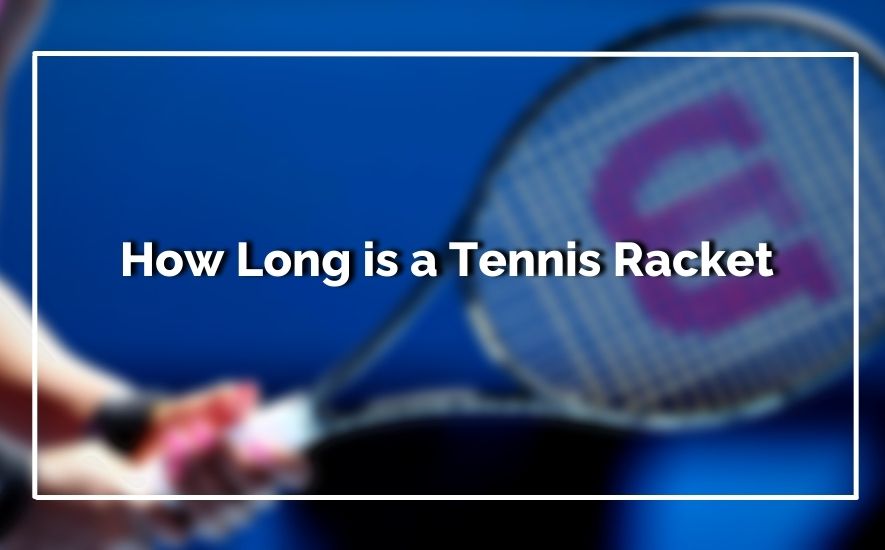In the dynamic world of tennis, where precision and finesse reign supreme, the tennis racket stands as a vital tool in a player’s arsenal. This seemingly unassuming instrument holds within its design a crucial factor that can significantly influence a player’s performance on the court.
How Long is a Tennis Racket? The standard length of a tennis racket typically ranges between 27 to 29 inches. This dimension, while subject to slight variations among different manufacturers and models, is meticulously designed to ensure optimal balance and control for players, influencing their reach, power, and maneuverability.
The length of a tennis racket, a key dimension often overlooked by spectators, is a subtle yet essential element that can impact a player’s reach, control, and power during each intense rally. In this article, we’ll uncover the intricate role that the racket’s length plays in shaping the dynamics of the game, shedding light on its significance and influence.
Table of Contents
How Long is a Tennis Racket and Its Impact on Your Game
Understanding the length of a tennis racket is a crucial aspect of optimizing your gameplay. Tennis rackets come in various sizes, typically ranging from 27 to 29 inches. The length of a tennis racket can significantly influence your reach, swing, and overall performance on the court.
A longer racket often provides additional leverage, enhancing your serve and volley capabilities. Conversely, a shorter racket offers more maneuverability, ideal for players seeking quick reactions at the net. Choosing the right length tailored to your playing style can make a substantial difference in your tennis experience. So, whether you’re looking for extended reach or nimble control, knowing how long a tennis racket is can be the key to unlocking your full potential on the court.
Exploring Different Tennis Racket Sizes
Tennis enthusiasts understand the pivotal role that a well-suited racket size plays in enhancing their game. Selecting the right racket size involves considering various factors that can significantly impact your playing style and overall performance on the court.
The Importance of Racket Size
The size of a tennis racket is a critical element that directly affects a player’s game. A racket that complements your playing style and physical attributes can make a remarkable difference in power, control, and maneuverability.
It’s essential to find a balance between these factors to optimize your performance. Larger racket heads offer a larger sweet spot, enabling more powerful shots, while smaller racket heads provide better control and precision.
Variations in Racket Sizes
Tennis rackets come in a spectrum of sizes, typically categorized as standard, mid-plus, and oversized. Standard rackets offer a balance between power and control, making them suitable for a wide range of players.
Mid-plus rackets provide a slightly larger sweet spot and are favored by players who seek a blend of power and precision. On the other hand, oversized rackets maximize the sweet spot, making them ideal for beginners and those looking for increased power without perfect ball placement.
Matching Racket Size to Playing Style
Selecting the appropriate racket size goes hand in hand with understanding your playing style. For players with an aggressive, power-oriented game, a larger racket head may provide the necessary boost to their shots.
Meanwhile, those who prioritize finesse and accuracy might opt for a smaller racket head to maintain better control over their placement and spin. It’s crucial to assess your strengths and weaknesses to determine which racket size aligns best with your natural style of play.
Considerations for Junior Players
When exploring tennis racket sizes for junior players, additional factors come into play. Junior players should be equipped with rackets that suit their age, height, and physical development.
Oversized rackets can aid in building confidence and mastering ball contact, making them a popular choice for young beginners. As junior players progress, they can gradually transition to more standard sizes, allowing for a smoother development of their skills.
Finding Your Perfect Fit: Tennis Racket Length Guide
Tennis, a sport that combines agility, power, and precision, demands the right equipment to enhance your performance. One crucial element often overlooked is the length of your tennis racket. Choosing the right racket length can significantly impact your game, affecting your swing mechanics, power, and control.
Understanding Tennis Racket Lengths
Tennis rackets come in various lengths, typically ranging from 27 to 29 inches. The length directly influences the racket’s leverage, swing radius, and maneuverability. Longer rackets provide increased reach, generating more power due to their extended leverage.
Conversely, shorter rackets offer greater control and ease of maneuvering. It’s important to note that racket length is not an arbitrary choice; rather, it should align with your playing style, physical attributes, and skill level.
Matching Racket Length to Playing Style
Your playing style serves as a pivotal factor in determining the ideal racket length for you. If you’re an aggressive baseline player who relies on powerful groundstrokes, a longer racket can amplify your shots, allowing you to hit with more depth and spin.
On the other hand, if you prefer a finesse-based approach with volleys and net play, a shorter racket grants you the control needed for precise shots and quick reactions. Consider your natural strengths and strategy to gauge which racket length complements your style of play.
Factoring in Physical Attributes
Your physical attributes, such as height and arm length, play a significant role in the racket length selection process. Taller players often find longer rackets advantageous, as the added length compensates for their height and enhances their reach across the court.
Meanwhile, shorter players might opt for a slightly shorter racket to maintain maneuverability without sacrificing control. It’s essential to strike a balance between your physique and racket length to optimize your on-court performance.
Navigating Skill Levels and Comfort
Novice players and those transitioning to a new racket length should prioritize comfort and adaptability. A slightly longer racket can provide a gradual adjustment period, allowing your muscles to acclimate to the new mechanics.
As you progress and refine your technique, you can explore different lengths to fine-tune your game. Advanced players might experiment with racket lengths to exploit specific strengths or address weaknesses. Regardless of skill level, the key is to find a length that feels natural and empowers your gameplay.
Consulting with Experts and Testing
While this guide offers valuable insights, the ultimate decision on racket length should be personalized. Consulting with tennis professionals, coaches, or knowledgeable racket specialists can provide tailored recommendations based on your unique attributes and goals.
Additionally, testing different racket lengths through demo programs or borrowing rackets from fellow players can offer firsthand experience, aiding you in identifying the perfect fit for your game.
The Impact of Tennis Racket Length on Performance
Tennis, a game of precision and strategy, has evolved significantly over the years, witnessing changes in equipment and playing styles. One crucial factor influencing a player’s performance is the length of the tennis racket.
The dimensions of the racket, including its length, can affect various aspects of a player’s game, ranging from power and control to maneuverability and spin. Understanding the impact of tennis racket length on performance is essential for players seeking to optimize their gameplay.
Physics of Racket Length and Power:
The length of a tennis racket directly influences the player’s ability to generate power in their shots. A longer racket provides a greater leverage advantage, enabling players to generate higher racket head speeds. This, in turn, translates into more powerful shots.
The increased momentum due to the longer racket enhances the potential for forceful serves and groundstrokes, enabling players to hit the ball harder and deeper into the court.
Precision and Control:
While longer rackets offer increased power, they can potentially compromise a player’s control over the ball. Shorter rackets, on the other hand, often offer better precision and maneuverability.
The reduced length allows for quicker adjustments, making it easier to execute shots with accuracy. Players who prioritize control and placement might opt for a slightly shorter racket to maintain finesse and placement during rallies.
Maneuverability and Agility:
Tennis matches often involve rapid changes in direction and quick reaction times. The length of the racket can impact a player’s agility and maneuverability on the court. Shorter rackets are generally lighter and easier to swing, enabling players to react swiftly to incoming shots. Longer rackets might be advantageous in situations requiring extended reach, but they may be slightly cumbersome in fast-paced exchanges.
Spin Generation and Shot Variation:
The relationship between racket length and spin generation is an intriguing aspect to explore. A longer racket can potentially provide more “whip” in shots, leading to increased topspin.
This additional spin can result in shots that bounce higher and dive into the court, making it challenging for opponents to handle. On the contrary, shorter rackets can encourage players to generate spin through their technique, enhancing shot variation.
Player Preferences and Adaptation:
Ultimately, the choice of racket length often comes down to player preferences and playing style. Some players may naturally excel with longer rackets due to their physical attributes, while others might find shorter rackets better suited to their game.
Players can experiment with different racket lengths to find the perfect balance between power, control, and maneuverability. Regular practice and adaptation to the chosen racket length are vital for players to optimize their performance and elevate their skills on the court.
How to Measure Tennis Racket Length
When it comes to selecting the right tennis racket, understanding its dimensions is crucial. One of the essential aspects to consider is the racket’s length, which directly impacts your gameplay.
Choosing the Correct Tools:
Before you begin measuring, gather the necessary tools. You’ll need a measuring tape or ruler, preferably one with both metric and imperial measurements. Lay the racket on a flat surface, ensuring the grip is aligned parallel to the measuring tool.
Measuring the Total Length:
To measure the total length of your tennis racket, start from the bottom of the handle (butt cap) and extend the measuring tape or ruler along the racket’s frame up to the tip.
Make sure the racket is resting flat and not on its side, as this may lead to inaccurate measurements. The total length is the distance between these two points, encompassing the entire racket frame.
Measuring the Grip Length:
The grip length is another significant dimension to consider. It determines how much of the racket handle is available for your hand placement. To measure the grip length, begin at the butt cap’s end and extend the measuring tape or ruler along the handle until you reach the start of the throat or shaft. This measurement gives you an idea of the handle’s usable space, which impacts your grip and control during play.
Assessing the Ideal Length for You:
Once you have the measurements, it’s time to determine the ideal racket length for your playing style. Racket length can vary based on personal preference, playing technique, and physical attributes.
Generally, longer rackets provide more power and reach, while shorter ones offer greater maneuverability. Consider your strengths and weaknesses on the court, seeking advice from coaches or experienced players if needed, to find the perfect balance.
Considering Other Factors:
While racket length is important, remember that it’s just one of several factors that contribute to your overall performance. Balance, weight, head size, and string pattern are also vital considerations. By evaluating all these elements together, you can make a well-informed decision that enhances your gameplay and helps you reach your full potential on the tennis court.
Customization and Tennis Racket Length: Tailoring Your Equipment
In the world of tennis, where precision and technique are paramount, the significance of customizing your equipment cannot be overstated.
One vital aspect of customization is selecting the ideal racket length that complements your playing style and physique. This process involves a careful balance between personal preferences and technical considerations, ultimately shaping your game on the court.
Personalized Performance: Matching Racket Length to Playing Style
Every tennis player boasts a distinct playing style, and racket length customization can be a game-changer in maximizing your strengths.
Aggressive baseliners might opt for a longer racket for explosive serves and groundstrokes, while net players may lean towards shorter rackets for quicker reactions during volleys. It’s crucial to align your chosen racket length with your preferred strategies to unlock your full potential on the court.
Physical Factors: The Intersection of Biomechanics and Racket Length
Customizing racket length also involves a careful assessment of your physical attributes. Your height, arm length, and strength significantly impact how you handle the racket. Taller players might find longer rackets advantageous in covering the court efficiently, while shorter players could benefit from the agility offered by shorter rackets.
Collaborating with a tennis coach or equipment specialist to analyze these biomechanical aspects ensures that your chosen racket length harmonizes seamlessly with your body mechanics.
Balancing Power and Control: The Fine-Tuning Process
The customization journey delves into the nuanced interplay between power and control. A longer racket generally generates more power, but it might sacrifice some precision and control in the process.
Conversely, a shorter racket can provide greater control but might require additional effort to generate power. Achieving the perfect equilibrium between these two pivotal elements necessitates trial and experimentation, often involving adjusting string tension and racket head size in conjunction with the chosen length.
Consulting Experts: The Role of Professionals in Customization
Embarking on a racket length customization journey can be both exciting and daunting. Seeking guidance from tennis professionals, coaches, or equipment specialists can provide invaluable insights into making informed decisions.
These experts possess a wealth of experience and knowledge, aiding you in deciphering the complexities of racket length customization and ensuring that your customized racket becomes an extension of your playing style and skills.
Conclusion
In the captivating world of tennis, the length of a tennis racket unveils an artful blend of science and performance. As we explore the dimensions that define this dynamic instrument, it becomes evident that its length is not merely a numerical attribute, but a pivotal factor in player control and power.
By harmonizing tradition with innovative materials and engineering, tennis racket length orchestrates a symphony of precise serves, dazzling volleys, and thunderous forehands on the court. It’s a testament to the ceaseless pursuit of excellence in sports technology, where every centimeter crafts a unique rhythm in the hands of players, forging an exhilarating connection between player and racket.
What is the standard length for a tennis racket?
The official standard length for a tennis racket is 27 inches or 68.58 cm. This measurement is for the total length of the frame from the top of the handle to the tip of the head. All regulation tennis rackets, whether for singles or doubles play, must adhere to this length requirement to be legal for sanctioned tennis tournaments and competitive play.
Why is there a standard racket length?
Having a standard racket length provides consistency and fairness in competitive tennis. It ensures that no player can gain an advantage by using an excessively large racket head. The standard size also allows clearance around the racket for proper swings and strokes. Racket length limits have been part of tennis rules for over a century.
Do racket lengths vary at all?
While 27 inches is the required length, many rackets have a slightly longer length around the stated size to allow for stringing and string movement while playing. So the total length may be 27.25 inches or 27.5 inches when strung. There can also be minor variations in handle length based on grip size. But all legal rackets will be very close to the standard 27-inch length.
What are extended-length rackets?
Extended-length rackets that go beyond the 27-inch limit are also produced. These oversized, specialty rackets may be 27.5-28 inches long. Since they exceed official regulations, they are illegal for competitive tournaments but can be used recreationally. The extra length allows for more power and reach.
Do doubles rackets have a different standard size?
No, regulation doubles rackets follow the same 27-inch standard length rule. Doubles rackets may have slightly wider heads and string spacing optimized for volleys, but the length remains 27 inches for legal tournament doubles play.



